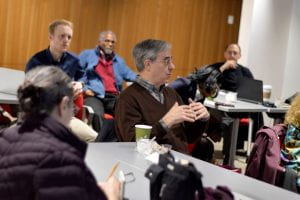 The February 7th Conversation on Community Engaged Scholarship focused on facilitating a deeper reflection.
The February 7th Conversation on Community Engaged Scholarship focused on facilitating a deeper reflection.
Dr. Wendy Wagner, the Nashman Center's Director of Community Engaged Scholarship (CES), facilitated a discussion that focused on how community engaged scholarship courses can include more of the pathways of service, ways to weave critical reflection from service into class discussions (and vice versa), and resources to help facilitate deeper critical reflections about service.
Going beyond direct service, the other Pathways of Service. While direct service continues to be an impactful and accessible pathway of service, faculty discussed ways to engage students in community organizing and activism, policy and governance, and social innovation. To engage students in some of the other pathways, faculty members suggested first organizing students into groups and then pairing the group of students with a community partner. With the students already in groups, a community partner may be more willing to train the group students in a particular area (ex. the community partner’s social media platform) because students, serving on a rotation, would be able to help the community partner the whole semester.
Logistically, faculty recognize that this organizing and pairing would be difficult at first. However, by establishing a partnership early on, each semester new students would be able to continue the previous students’ work. This partnership would be maintained as new students took the course. Not only would students be able to actively engage and participate in the other pathways of service, but community engaged scholarship courses would be able to strengthen GW’s relationship with community partners.
In fact, this semester, a group of students in BADM 1002 are putting this idea into practice as they complete their service at Food and Friends. As a group, the students will be trained on Food and Friends’ social media platform and volunteer on a rotation basis throughout the semester.
Weaving critical reflections from service into class discussions. In effort to incite deeper critical reflections, faculty emphasized that online discussions and class discussions are two productive ways to help students integrate theory with practice. Class discussions, either online or in-person, encourage students to integrate their service learning with class discussions and to differentiate critical thinking from streams of consciousness. With this being said, faculty noted their multidirectional efforts to have students approach critical thinking as a constant thought process.
Resources for facilitating critical thinking. While there are different frameworks for service learning according to the area of academic study, thoughts from Aday, “Bloom’s Taxonomy,” Brookfield, Mezzero, and Mitchell came up in the discussion. Human Services & Social Justice courses tend to use the “So What, Now What” framework, while Public Health courses use the “Vulnerable Populations” framework by Louanne Aday. To enhance students’ critical thinking, a faculty member mentioned that they would have students come up with their own frameworks to analyze issue areas. This way, students critically engaged with the issues by creating a framework to explain and understand them.
Faculty members also discussed rubrics to grade critical reflections and writing assignments that focus on service learning and civic engagement.
Thank you to everyone who came and participated in this thoughtful discussion.

